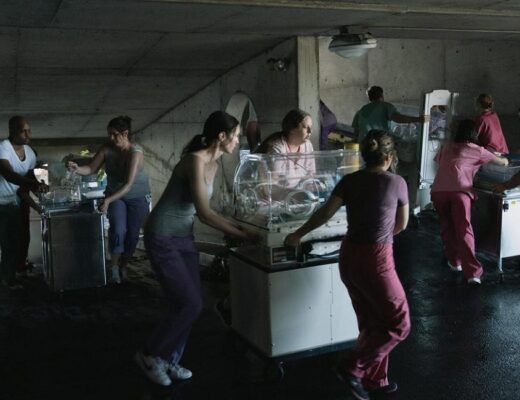One of two films debuting in this year’s Directors’ Fortnight by actresses thrust into the spotlight thanks to Céline Sciamma’s masterful Portrait of a Lady on Fire, Franco-Kosovar director Luàna Bajrami’s The Hill Where Lionesses Roar articulates a vision of youthful emancipation. Qe (Flaka Latifi), Jeta (Uratë Shabani), and Li (Era Balaj) are teenage girls, or lionesses: they yearn and hunt for freedom, for that wild feeling of adrenaline and to be invulnerable against anything and everything. Their lives center around the film’s titular hill, a rustic Kosovan landscape that tethers them to a home they have outgrown and long to escape from, just as it shields them from an unsympathetic world beyond their own.
The film’s striking imagery, such as the modern chiaroscuro of gems against the quiet of a nocturnal theft, or of the three girls staring into the camera, bloody and bare-chested, presents a discordant challenge to the solar pastorals of village life. These bolder, brasher strokes envision a world where these young women could, for example, drive around a stolen Jaguar without question. Bajrami’s rebellious spirit is however less an antithesis of tradition — against family or culture — and more an affirmation of her heroines’ burgeoning independence; that they must upend the rhythm of their lives in order to live freely and according to their desires. Her frequent use of static shots portrays them as if the eponymous lions on a preserve, darting in and out of the frame, rarely interacting with the rest of a society they will inevitably fall in line with. There’s a bit of stylistic showmanship in these sequences, preoccupied at times with photographic composition at the expense of naturalistic continuity, a flourish that reveals Bajrami’s fledgling directorial experience. A cathartic energy similarly courses through the film, emblematic of (as is typical of many debuts) its unpolished personal expression.
Nevertheless, The Hill Where Lionesses Roar often proves authentic and heartfelt, especially in the characterization of its three leads. Bajrami likewise exudes a tender appreciation for her setting, carefully mapping out the lionesses’ emotionally complex relationship with home. The director herself appears in the film, as one of two side characters who make their way into these young lives. As recent festival jury darlings like Exile, Hive, and Looking for Venera have placed Kosovo on the critical radar, Bajrami’s addition to this national oeuvre furthers its nuanced exploration of cultural and generational identity, mediating between a land and its zealous youth. (In the film’s press notes, Bajrami contrasts her impression of the country with her sister’s; she is fascinated by it as much as the latter considers it a prison.) Though largely plotless, The Hill Where Lionesses Roar does not devolve into whispers; its freewheeling sorority, reminiscent of such recent Cannes selections as Djam and Divines, fiercely juxtaposes desire with defiance: a girlhood of rebellion in which love and crime aren’t worlds apart. Its languid pacing may fail to enamor us with Bajrami’s thinly-sketched first act, but the gradual accumulation of her solar-powered compositions into the echoing roar of the three lionesses leaves a firm impression by the time the credits roll.
Published as part of Cannes Film Festival 2021 — Dispatch 1.







